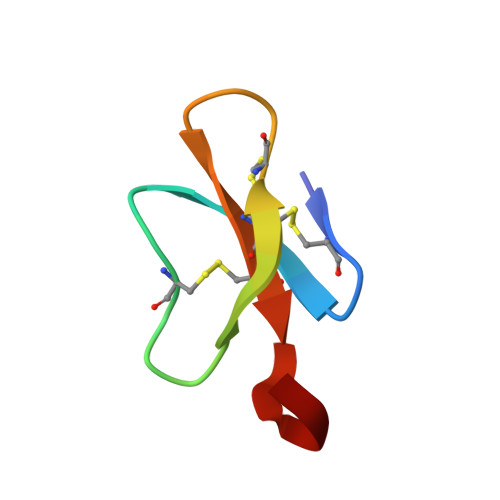Initial insights into structure-activity relationships of avian defensins.
Derache, C., Meudal, H., Aucagne, V., Mark, K.J., Cadene, M., Delmas, A.F., Lalmanach, A.C., Landon, C.(2012) J Biol Chem 287: 7746-7755
- PubMed: 22205704
- DOI: https://doi.org/10.1074/jbc.M111.312108
- Primary Citation of Related Structures:
2LG5, 2LG6 - PubMed Abstract:
Numerous β-defensins have been identified in birds, and the potential use of these peptides as alternatives to antibiotics has been proposed, in particular to fight antibiotic-resistant and zoonotic bacterial species. Little is known about the mechanism of antibacterial activity of avian β-defensins, and this study was carried out to obtain initial insights into the involvement of structural features or specific residues in the antimicrobial activity of chicken AvBD2. Chicken AvBD2 and its enantiomeric counterpart were chemically synthesized. Peptide elongation and oxidative folding were both optimized. The similar antimicrobial activity measured for both L- and D-proteins clearly indicates that there is no chiral partner. Therefore, the bacterial membrane is in all likelihood the primary target. Moreover, this work indicates that the three-dimensional fold is required for an optimal antimicrobial activity, in particular for gram-positive bacterial strains. The three-dimensional NMR structure of chicken AvBD2 defensin displays the structural three-stranded antiparallel β-sheet characteristic of β-defensins. The surface of the molecule does not display any amphipathic character. In light of this new structure and of the king penguin AvBD103b defensin structure, the consensus sequence of the avian β-defensin family was analyzed. Well conserved residues were highlighted, and the potential strategic role of the lysine 31 residue of AvBD2 was emphasized. The synthetic AvBD2-K31A variant displayed substantial N-terminal structural modifications and a dramatic decrease in activity. Taken together, these results demonstrate the structural as well as the functional role of the critical lysine 31 residue in antimicrobial activity.
Organizational Affiliation:
Centre de Biophysique Moléculaire, CNRS UPR4301, rue Charles Sadron, 45071 Orléans, France.














